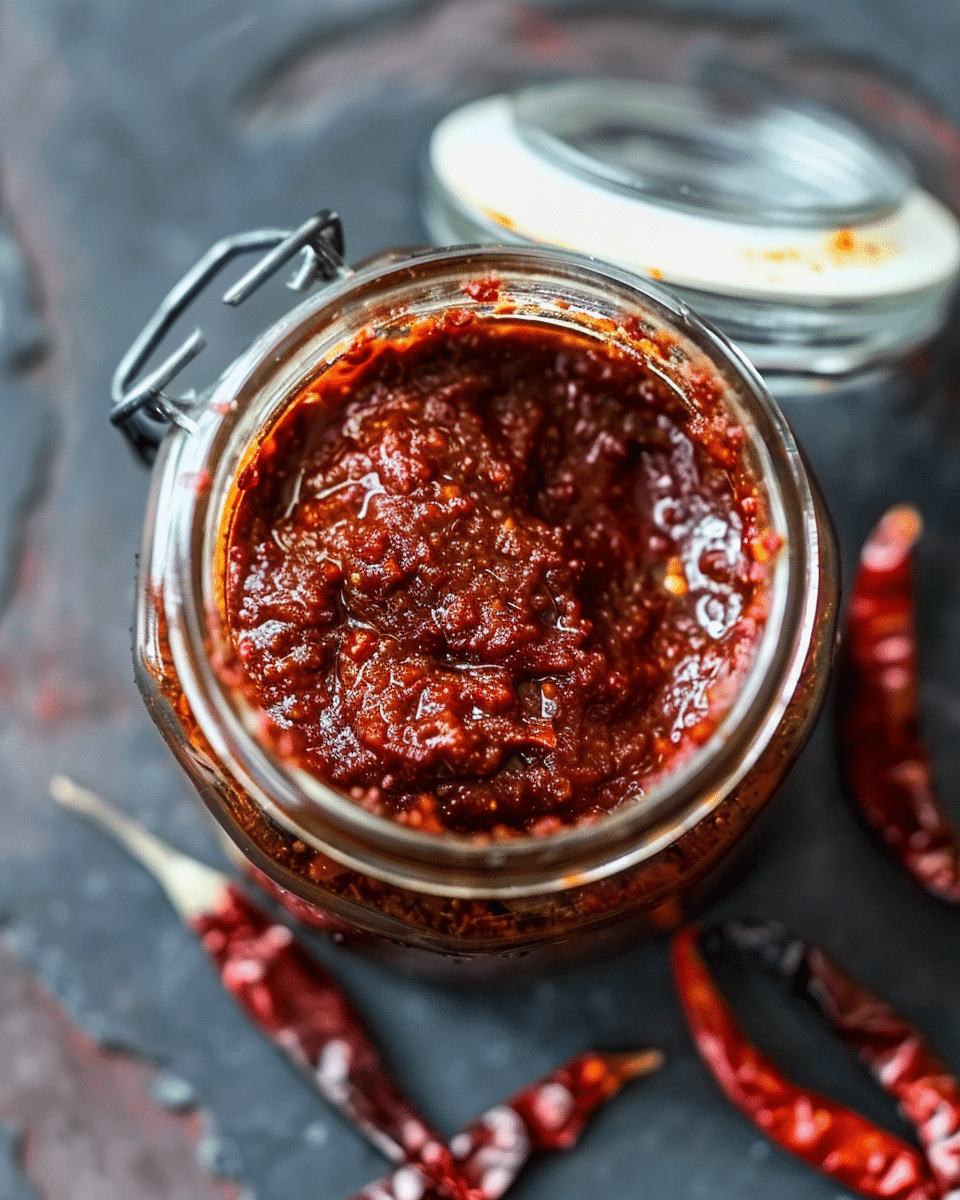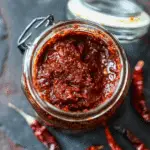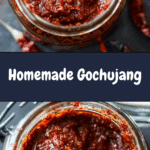Homemade Gochujang A bold, spicy, and umami-rich staple in Korean cuisine, gochujang is a thick, fermented chili paste with layers of flavor that develop over time. This homemade version is deeply satisfying and delivers everything I look for in a traditional Korean condiment—spice, sweetness, and a rich, fermented depth. It’s versatile enough to use in bibimbap, marinades, stews, and sauces, yet simple enough to make with a few key ingredients.

Ingredients
(Tip: You'll find the full list of ingredients and measurements in the recipe card below.)
1 cup sweet rice flour (also called glutinous rice flour)
3 cups water
½ cup fermented soybean powder (meju garu)
1 ½ cups Korean red chili pepper powder (gochugaru)
½ cup malt barley syrup (or rice syrup)
½ cup sea salt
Optional: 2 tablespoons sake or mirin (for a slightly sweeter, more aromatic result)
Directions
I start by whisking the sweet rice flour into water in a medium saucepan until smooth.
Then I heat the mixture over medium heat, stirring constantly, until it thickens into a shiny, smooth paste—this takes about 10 to 12 minutes.
After removing it from the heat, I let it cool for about 10 minutes.
I stir in the fermented soybean powder until fully blended.
Next, I mix in the gochugaru and salt, ensuring the paste takes on a deep, vibrant red color.
I finish by adding the barley syrup (and sake or mirin, if I’m using it), stirring well to get that sticky, rich texture.
I transfer the finished paste into a clean glass jar or airtight container.
Fermentation Option:
To ferment it traditionally, I cover the jar with cheesecloth or a breathable lid and leave it in a cool, dry spot with indirect sunlight for 2 to 4 weeks, stirring every few days. Once it reaches the flavor I like, I seal it tightly and store it in the fridge.
Quick Option:
If I’m in a rush, I skip the fermentation and just refrigerate it immediately. The flavor continues to improve over time in the fridge.
Servings and timing
Servings: About 3 cups
Prep Time: 20 minutes
Cooking Time: 10 minutes
Total Time: 30 minutes (plus optional 2–4 weeks fermentation)
Calories: Approximately 35 kcal per tablespoon
Variations
I sometimes add more or less gochugaru to adjust the heat.
For a gluten-free version, I make sure all ingredients (especially barley syrup or substitutes) are certified gluten-free.
I’ve used rice syrup instead of barley syrup for a slightly milder sweetness.
Adding sake or mirin gives a sweeter, more aromatic profile that I really enjoy.
For a smokier flavor, I’ve tried blending in a small amount of smoked paprika.
Storage/Reheating
I store gochujang in a tightly sealed glass jar in the refrigerator. Properly fermented, it keeps for up to 6 months. I always use a clean spoon when scooping some out to keep it free from contamination. Reheating isn’t necessary for gochujang, as it’s used cold or added directly to cooking.
FAQs
What does gochujang taste like?
To me, gochujang has a complex flavor that’s spicy, savory, slightly sweet, and full of umami. The fermentation adds depth and a pleasant funk that makes it irresistible in Korean dishes.
Is homemade gochujang better than store-bought?
I find homemade gochujang to be richer and more customizable. I can adjust the heat, sweetness, and saltiness to suit my taste, and the fresh, fermented flavor is hard to beat.
Can I use regular chili powder instead of gochugaru?
I don’t recommend substituting regular chili powder because it doesn’t have the same heat or texture. Gochugaru has a fruity, smoky quality that’s essential for authentic gochujang.
How do I know when the gochujang is done fermenting?
I look for a deeper color, a slightly tangy smell, and a mellowing of the chili’s sharpness. I taste it every few days after the first week to check how the flavor is developing.
Is it necessary to ferment gochujang?
While fermentation gives it traditional flavor and complexity, I’ve skipped it before when short on time. The unfermented version still tastes great and improves over time in the fridge.
Conclusion
Making homemade gochujang is one of the most satisfying things I’ve done in my kitchen. Whether I take the time to ferment it or use it right away, the result is a deeply flavorful condiment that enhances everything I put it on. With just a few ingredients and some patience, I get a Korean staple that’s bold, balanced, and unmistakably delicious.
Recipe:

Homemade Gochujang
5 Stars 4 Stars 3 Stars 2 Stars 1 Star
No reviews
- Author: Cheryl
- Total Time: 30 minutes (plus optional 2–4 weeks fermentation)
- Yield: About 3 cups
- Diet: Vegan
Description
A bold, spicy, and umami-rich Korean fermented chili paste made from sweet rice flour, fermented soybean powder, and Korean chili flakes. This homemade gochujang is vegan, gluten-free, and offers authentic depth of flavor from fermentation.
Ingredients
1 cup sweet rice flour (glutinous rice flour)
3 cups water
½ cup fermented soybean powder (meju garu)
1 ½ cups Korean red chili pepper powder (gochugaru)
½ cup malt barley syrup (or rice syrup)
½ cup sea salt
Optional: 2 tablespoons sake or mirin
Instructions
- In a medium saucepan, whisk the sweet rice flour into the water until smooth.
- Heat over medium heat, stirring constantly, until the mixture thickens into a shiny, smooth paste (about 10–12 minutes).
- Remove from heat and let cool for 10 minutes.
- Stir in the fermented soybean powder until fully blended.
- Add the Korean chili powder (gochugaru) and salt, mixing until the paste becomes a deep red color.
- Stir in the barley syrup (and sake or mirin, if using) until the texture is thick and rich.
- Transfer the paste into a clean glass jar or airtight container.
- Fermentation Option: Cover with cheesecloth or a breathable lid and leave in a cool, dry spot with indirect sunlight for 2 to 4 weeks, stirring every few days. Once fermented to taste, seal and refrigerate.
- Quick Option: Skip fermentation and refrigerate immediately. Flavor improves over time.
Notes
Adjust the amount of gochugaru to control spice level.
Use certified gluten-free ingredients for a gluten-free version.
Rice syrup offers a milder sweetness compared to barley syrup.
Sake or mirin adds sweetness and aroma.
Store in a sealed jar in the fridge for up to 6 months.
Always use a clean spoon to avoid contamination.
- Prep Time: 20 minutes
- Cook Time: 10 minutes
- Category: Condiment
- Method: Fermentation
- Cuisine: Korean
Nutrition
- Serving Size: 1 tablespoon
- Calories: 35
- Sugar: 4g
- Sodium: 400mg
- Fat: 0g
- Saturated Fat: 0g
- Unsaturated Fat: 0g
- Trans Fat: 0g
- Carbohydrates: 8g
- Fiber: 1g
- Protein: 1g
- Cholesterol: 0mg





